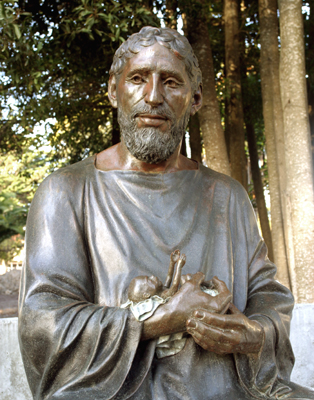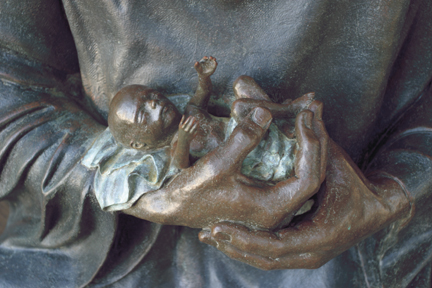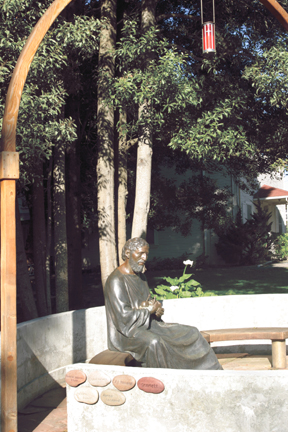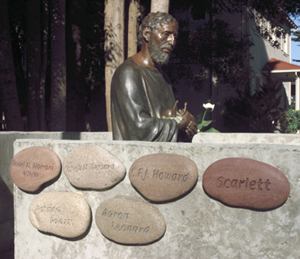 Contents
Contents
- St. Joseph, patron and model of love and respect for life in the womb
- Process of post-abortion healing and reconciliation
- St. Joseph, who named Jesus, aids in naming the child
- Reconciling with the child and God
- St. Joseph, model of trust in Divine Providence, invites to entrust child to the Lord
- Conclusion
St. Joseph, patron and model of love and respect for life in the womb
In both the opening paragraph and the closing chapter of Redemptoris Custos, Pope John Paul II emphasizes St. Joseph’s role as patron and protector of the Church. The sound traditional reasoning for this concludes that since his mission was to guard and care for the physical body of Christ on earth, so is his mission now to continue to care for the mystical body of Christ, the Church.
St. Joseph’s role as universal patron is not only to protect the Church, but also to provide a “noble example, which transcends all individual states of life and serves as a model for the entire Christian community, whatever the condition and duties of each of its members may be.” He is a model of the evangelical virtues for all, but among those given particular mention are parents (along with spouses, workers, contemplatives and apostles).
Looking to St. Joseph as model and patron of parents, we may learn something about even the earliest stages of parenthood, prior to birth. These stages are so crucial in this era of widespread abortion, denial of the humanity of the child in the womb and the consequent denial of parenthood. We learn from the angel of the Lord that Joseph is father of the child in Mary’s womb by virtue of his marriage, a clear message that it is of the essence of marriage for husband and wife to receive, nurture and bring to birth life conceived in the womb.
In our times, though, abortion is defended by posing questions about all the irregular situations: What about rape, incest, “unwanted” out-of-wedlock, and teen-age pregnancies? Although the circumstance is of quite a different nature, Joseph too is faced with the most irregular of all pregnancies, a situation leaving him quite unsettled: his wife has conceived by the Holy Spirit! The child is not his biologically or genetically. It is not the fruit of his physical relationship with his wife. In fact he is called to believe that the child is conceived not by physical relationship with any man, but by the unique and direct intervention of God. How can a man accept such an overwhelming pregnancy? Only by faith. How can he accept fatherhood over such a child that could be called not his own? Only by openness to the will of God, by willingness to do as the angel of the Lord tells him.
We learn from Joseph that fatherhood is much more than simple physical generation.  In fact Joseph, who does not engender any child at all, is the best of fathers and a model for every father. He accepts the life in the womb by honorably taking Mary his wife. He journeys with her to Bethlehem to register the child in the list of humanity. He gives the child a name in the line of David. He defends the child from the cruel attack of Herod.
In fact Joseph, who does not engender any child at all, is the best of fathers and a model for every father. He accepts the life in the womb by honorably taking Mary his wife. He journeys with her to Bethlehem to register the child in the list of humanity. He gives the child a name in the line of David. He defends the child from the cruel attack of Herod.
Joseph was the one chosen for the role of father to the Son of God incarnate in Mary’s womb, and he fulfilled this role so faithfully. Within his universal patronage, it is certainly fitting in our times that he be given a new title as “Patron of the Unborn.” No one can be a better defender of innocent, helpless life in the womb. No one is a better model of fatherhood to parents of pre-born children. No one can more fittingly aid in the process of healing and reconciliation for those who grieve and agonize over having committed the sin of abortion. No one is a better image for women who have been hurt by men unwilling to accept fatherhood of the child they engendered.
Process of post-abortion healing and reconciliation
 In The Gospel of Life, the Holy Father addresses a special word to women who have had an abortion:
In The Gospel of Life, the Holy Father addresses a special word to women who have had an abortion:
The wound in your heart may not yet have healed. Certainly what happened was and remains terribly wrong. But do not give in to discouragement and do not lose hope. Try rather to understand what happened and face it honestly. If you have not already done so, give yourselves over with humility and trust to repentance. The Father of mercies is ready to give you his forgiveness and his peace in the Sacrament of Reconciliation. You will come to understand that nothing is definitively lost and you will also be able to ask forgiveness from your child, who is now living in the Lord.
Totally contrary to the manner in which it is presented, abortion does not solve or put closure to a problem. Terrible grief and guilt remain in the mother, father, relatives and perpetrators of abortion. These pains are usually denied or repressed, thus remaining unmourned. All types of negative consequences have been identified, from depression to alienation, drug abuse, intimacy problems, and suicidal tendencies.
A number of processes have been developed for post-abortion reconciliation and healing, the most successful of which is “Project Rachel.” Steps include having the mother tell her story with all its pain, grieve her loss, acknowledge the uniqueness of her child and give it a name, ask forgiveness of her child, ritualize her loss, accept God’s forgiveness, and forgive herself.
At the Shrine of St. Joseph, Guardian of the Redeemer in Santa Cruz, California, the Oblates of St. Joseph in 2001 have erected a bronze statue of a seven foot tall St. Joseph seated on a curved bench holding a six month old fetus in his hands. St. Joseph faces another curved bench where a person may sit in prayer. The artist, Thomas Marsh, has made St. Joseph’s facial expression to reflect God’s love, the gravity of the situation, grief, forgiveness, protective strength, tenderness and comfort for the baby, and peace. The baby has his arms extended above toward a perpetually burning light which will represent Christ. The area is enclosed by two semi-circular barriers for a sense of privacy. These barriers will also hold little plaques engraved with the names of aborted or miscarried babies that have been entrusted to the Lord through the hands of St. Joseph.
St. Joseph, who named Jesus, aids in naming the child
The angel’s first words to Joseph are “Joseph, son of David,” addressing him by the title that already indicates his vocation with respect to the child conceived in the womb of his betrothed. He is to pass on the Davidic lineage that is necessary for the fulfillment of the prophecy that the Messiah would be a descendant of David. He is the legal father who will officially register the child in the human rolls in Bethlehem, the city of David.
The angel then makes explicit Joseph’s role to give the child the personal name that indicates his identity: “you are to name him Jesus, because he will save his people from their sins.” Together with Mary at the circumcision, Joseph fulfills this command of the angel. In doing so he declares his legal fatherhood over Jesus, and proclaims the child’s mission as Savior. Without hesitation he accepts his responsibility as father, trusts in God’s love, and puts his faith in the salvation the child has come to bring.
 A mother (or father) who has aborted a child becomes most painfully aware of having denied God’s gift of love and of having attempted to rob her offspring of an identity. Often she has been “helped” to deny that the child was human, and to believe that if aborted before birth the child would never need to have a name. The process of spiritual healing involves coming out of denial and facing the reality of the humanity of her child. In order to reconcile with God and herself, she must reconcile with her child. Insofar as she is able, she must exercise now the parental role she had denied, and for which her motherly heart aches. She chooses a name for her child and thereafter always refers to her child by its name.
A mother (or father) who has aborted a child becomes most painfully aware of having denied God’s gift of love and of having attempted to rob her offspring of an identity. Often she has been “helped” to deny that the child was human, and to believe that if aborted before birth the child would never need to have a name. The process of spiritual healing involves coming out of denial and facing the reality of the humanity of her child. In order to reconcile with God and herself, she must reconcile with her child. Insofar as she is able, she must exercise now the parental role she had denied, and for which her motherly heart aches. She chooses a name for her child and thereafter always refers to her child by its name.
Since St. Joseph was the one chosen by God to name His own Son, and since he was told the specific name to give while the child was still in the womb, he is a most fitting model and patron for this important, but difficult step. He may be prayerfully invoked for assistance in choosing and giving the name.
Reconciling with the child and God
Once the child has been named, he (or she) may be memorialized, giving the parent a concrete, physical manner of honoring and remembering the child. The memorial validates her grief and gives her permission to grieve. That unique bond between parent and child may begin to grow.
A particular manner of memorializing the child is to have his (or her) name perpetually inscribed at the statue of St. Joseph, Patron of the Unborn, in Santa Cruz. The names line the walls of the monument. The children who were never buried or remembered anywhere now have a place where markers testify to the fact that they were individual live human beings brought into existence on this earth. They are not obliterated, since they were created by God with immortal souls. They remain close to that saint who was chosen to love and care for the Son of God from the time of his conception in the womb.
Following the ritual of memorializing the baby’s name, the mother may now enter into dialogue with her child, accepting the maternity she had denied, asking forgiveness from it as the Holy Father counsels, and making peace with it. This advances the process of spiritual healing.
St. Joseph, model of trust in Divine Providence, invites to entrust child to the Lord
On being called to act as father to God’s Son incarnate, St. Joseph was certainly aware of his human inability to fulfill such an important role. He could only respond by trusting in Divine Providence. He would do everything humanly possible, as he was asked, but the results would depend on God. This trust was exercised in taking Mary, his miraculously pregnant betrothed, to be his wife; in being able to find only a stable for the delivery of the child; and in having to flee into Egypt as a refugee to save Jesus from murderous Herod. Joseph knew that his child was God’s child, a knowledge dramatically reinforced on hearing Jesus’ response in the temple about his “Father’s house.”
Without having to resolve the question of whether aborted babies can go to Heaven when they have not been baptized, the grieving mother can learn from St. Joseph to trust in God’s Providence. As quoted above, the Holy Father refers to the child as “now living in the Lord.” The statue of the Patron of the Unborn shows St. Joseph holding the child tenderly as a father. The child’s arms are extended, reaching for Christ, the Light of the world. With the consent of the mother, seated before him, he offers the child to Christ’s infinitely loving embrace. St. Joseph leads the mother to trust God and entrust her child confidently to Jesus. The following is a prayer composed for this purpose:
O St. Joseph, after your most holy spouse, our Blessed Mother, you were the first to take into your arms and heart the baby Jesus. From the first time you gazed upon him and held him, your heart and soul were forever bonded to him. You caressed the Holy Child with fatherly love and affection, and you committed yourself always to love, protect, and care for this Son.
Look now with similar love and affection upon this child of mine, who has gone from this world. I place my child, as well as my grief and guilt, into the eternal embrace of your arms. Hold and caress my child for me with the love of my arms and sweetly kiss my child with all the tender affection of my heart.
As God the Father entrusted the care of His most precious Son into your most loving and confident hands, so too do I entrust into your fatherly care this child of mine. Please present him to the merciful hands of Our Lord, so that one day, when I too leave this world, my child may greet me into eternal life. Amen.
This entire process of reconciling with the child and entrusting it to God, is a powerful aid to reconciling with God. Administering the Sacrament of Penance (confession) is one of the principal daily ministries of the Shrine of St. Joseph, Guardian of the Redeemer, where the monument of the Patron of the Unborn is located. Having accepted her motherhood over her child, having asked forgiveness of it, and having placed her trust in God’s Providence, the mother is now able to repent before Him and accept His sacramental forgiveness. Truly believing in His forgiveness, she may forgive herself and seek closure.
Conclusion
St. Joseph, Model Husband and Father, The Most Excellent Patron Of Spouses and Parents, helps spouses to appreciate and live their vocation to life and love, and helps parents to respect the life of their unborn children and to reconcile after sinning against that life.
To have a baby memorialized you may contact the Shrine of St. Joseph.
